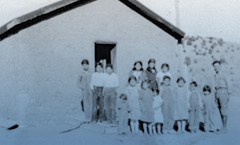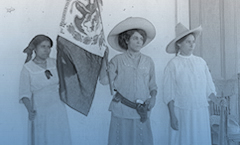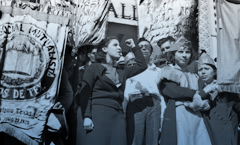Credits
Photography

Culture
“Lydia Mendoza in the 1950s,” n.d. Houston Metropolitan Research Center, Houston Public Library.
Lydia Mendoza was one of the first nationally known Tejana songwriters. Known as La Alondra de la Frontera [the meadowlark of the border] and la cancionera de los pobres [the people’s songwriter], she played musica ranchera, boleros and conjunto music in the many places Tejanas and Tejanos would gather to celebrate the end of a work-day or a work week: ice houses, bars, cantinas and public parks. She maintained an independent singing and recording career, and her circuit included Texas, Mexico, Cuba and the rest of the United States. Born in Houston, Texas in 1916, Lydia started touring in 1928 with Cuarteto Carta Blanca. In 1934, her song, “Mal Hombre,” became a national hit with Blue Bird label, and established a regular recording and touring career. In 1982, she was the first Texan honored with a National Endowment of the Arts Fellowship. Her skill with her 12 string guitar, her biting wit and her mastery of Tejano oral traditions made her live performances memorable. The success of her songs that reflect the desires and pains of working class Latinas and Latinos make her central to the larger history of popular culture in the Americas.
Yolanda Broyles-Gonzalez has published a translation of Lydia Mendoza’s life story, Lydia Mendoza’s Life in Music with Oxford University Press.

Society
George Isidore Sanchez, “School – San Miguel County, 1934” Digitization of the George Isidore Sanchez papers collection,
http://www.lib.utexas.edu/photodraw/sanchez/index.html
According to the web site, ), internationally renowned civil rights leader and educator, was chairman, 1951-59, of the Department of History and Philosophy of Education of The University of Texas at Austin, as well as director of the Center for International Affairs, and a member of the Executive Committee of the Institute of Latin American Studies. The George I. Sánchez Papers include 465 photographs made available here in digital form thanks to support from the University of Texas System Academic Library Collection Enhancement Program.
This image reflects the concern many Civil Rights leaders took to document the public policies and everyday conditions that shaped and too often diminished the possibilities available to Latinas and Latinos in the United States.

Identity
Robert Runyon, “Maria Gonzalez and Soldaderas,” The South Texas Border, 1900-1920: Photographs from the Robert Runyon Collection,
http://runyon.lib.utexas.edu/r/RUN00000/RUN00100/RUN00149.JPG
Many women picked up arms and joined the armed phase of the Mexican Revolution, and some even led their own divisions. Some people were uncomfortable with the presence of women as soldiers, guerrillas, and political participants. The label Soldaderas reflects their discomfort with the presence of women in the revolution, and is often used synonymously with the term camp follower. Since the Revolution, many women and historians have used photographs like this one to challenge the myth that The Revolution was an exclusively male and working-class endeavor.
Maria Gonzalez was part of Cruz Blanca, an organization formed in Laredo to provide medical aid for the soldiers and volunteers in Venustiano Carranza’s armies. the women in Cruz Blanca made their way to battlefields, often provided their own armed protection while in movement and raised their funds in cities across the United States and Northern Mexico. Their key organizer, Leonor Villegas de magnon, based herself out of Laredo, and wrote a fictionalized autobiography about her work with armed reform movements in Mexico and South Texas.
Robert Runyon was the society photographer in Brownsville and Matamoros, and was called on to offer his services when dignitaries came to the border. This photograph reflects the presence of the Revolution in the respectable parts of South Texas society.
For more work on these questions, see
Leonor Villegas de Magnon, la rebelde, (Houston: Arte Publico Press. 1994)
Emilio Zamora, The World of the Mexican Worker in South Texas (Austin: University of Texas Press, 1995)
Rosa Linda Fregoso, MeXicana Encounters: the Making of Social identities in the Borderlands (Berkeley: University of California Press, 2003)
Benjamin Johnson, Revolution in Texas: How a forgotten rebellion and its bloody suppression turned Mexicans into Americans, (New Haven: Yale University Press, 2004)
Anna Pegler Gordon, In sight of America: Photography and the Development of U.S. Immigration Policy, (Berkeley: University of California Press, 2009)

Politics
“Emma Tenayuca leading a 1937 Workers Alliance Demonstration on the steps of San Antonio’s City Hall.” San Antonio Light Collection, Institute of Texas Cultures, the University of Texas – San Antonio.
This image was taken during a demonstration organized by the Worker’s Alliance in San Antonio. In this demonstration, the Workers Alliance is demanding jobs and the right to organize for all workers in Texas, not just the citizens of the United States. Emma Tenayuca (1916-1999) became visible in the UCAPAWA [United Cannery and Packing and Agricultural Workers Assocation] campaigns for Pecan Shellers in San Antonio. Since the strike, Emma Tenayuca became a key organizer and intellectual in campaigns for Mexican and working class labor rights in Texas, affecting even the producers of the Mexican American Experience.
The theme Politics could be applied to almost all of the broadcasts in The Mexican American Experience and a esta hora conversamos. We chose to place broadcasts under the term politics when they involved active organizing against the status quo, people involved in politics, feminist movements, immigrant rights or labor organizing, or they pointed to an alternative understanding of American society.
For more information on Emma Tenayuca and Texas Chicano Politics see:
Zaragoza Vargas, Labor Rights are Civil Rights: Mexican American Workers in twentieth Century America, (Princeton: Princeton University Press, 2006)
Vicki Ruiz, From Out of the Shadows: Mexican Women in Twentieth Century America, (New York: Oxford University Press, 2002)
Teresa Palomo Acosta, Las Tejanas: 300 Years of History, (Austin: University of Texas Press, 2004)
